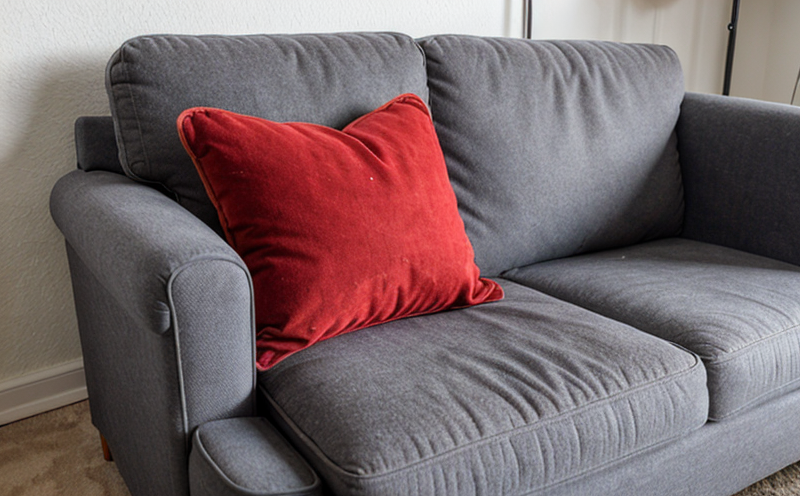ISO 3379 Determination of Strength and Performance of Upholstery Leathers Testing
The ISO 3379 standard is a crucial benchmark in the upholstery and furniture manufacturing industry. It specifies methods for determining the strength and performance properties of upholstery leathers, providing manufacturers with a standardized approach to assess the durability and quality of their products. This test is essential for ensuring that materials meet specific performance criteria, thereby enhancing product longevity and reliability.
The testing process involves subjecting upholstery leather samples to various mechanical stresses designed to simulate real-world conditions. The primary focus is on evaluating how well the leather withstands stretching, tearing, and abrasion over time. By understanding these properties, manufacturers can optimize their design processes, ensuring that the final products meet or exceed industry standards.
The ISO 3379 test protocol includes several key components:
- Sample preparation: Specimens are cut from the leather in accordance with specified dimensions and orientation to ensure consistent testing conditions.
- Testing apparatus: High-quality mechanical testers equipped with appropriate fixtures capable of applying controlled forces are used. These fixtures mimic typical loading scenarios encountered during use, such as sitting or moving on furniture.
- Data collection: Extensive data is gathered throughout the test, including force measurements and displacement values. This information allows for precise calculations of strength metrics like ultimate tensile strength (UTS), elongation at break, and energy absorption.
- Reporting: Comprehensive reports detailing all measured parameters are provided, offering insights into both the inherent properties of the leather itself as well as any potential variations due to manufacturing processes or batch differences.
The results from this testing can significantly influence several aspects of product development:
- Quality Assurance: Ensures that every batch of leather meets strict quality benchmarks before being used in production lines.
- Innovation: Helps identify areas where improvements could be made, leading to the creation of more robust and comfortable seating solutions.
- Customer Satisfaction: By delivering higher-quality products, companies enhance customer loyalty and trust within their markets.
In summary, adherence to ISO 3379 not only bolsters a company’s reputation but also plays a pivotal role in maintaining consistent product quality across all stages of manufacturing. It serves as an important tool for both current businesses seeking to maintain compliance with international standards and startups looking to enter this competitive market successfully.
Why It Matters
The importance of ISO 3379 lies in its ability to provide a reliable method for assessing the strength and performance characteristics of upholstery leathers. This is particularly significant because these materials are exposed to continuous stressors during daily use, making their durability critical to overall product success.
For manufacturers, meeting this standard ensures that they produce products capable of withstanding the rigours of everyday life without compromising on comfort or aesthetics. From high-end residential settings to commercial environments like offices and hospitality spaces, the ability to rely on tested materials enhances user experience significantly.
Moreover, compliance with ISO 3379 helps businesses stay competitive in a global market where consumers increasingly demand eco-friendly products made from sustainable resources. Leather sourced through rigorous testing processes often carries certifications that appeal directly to environmentally conscious buyers.
The standard also fosters innovation by encouraging continuous improvement based on scientifically validated data rather than guesswork. As technology advances, so too can the tests conducted under ISO 3379 guidelines evolve, ensuring that even cutting-edge materials remain up-to-date with industry best practices.
Applied Standards
In addition to ISO 3379, other relevant standards include:
- ASTM D1450: Standard Test Method for Determining the Tensile Properties of Leather Using a Metal Dog Clamped in a Universal Testing Machine
- EN 20384-1: Leather - Part 1: General Requirements and Definitions
- IEC 61967: Colorimetric Specifications for LED Lamps (while not directly related, this standard ensures that any lighting used in testing environments meets precise color specifications)
These standards collectively form a comprehensive framework guiding the evaluation of leather materials across various industries. By adhering to these guidelines, manufacturers ensure their products are not only functional but also meet stringent quality control measures.
Competitive Advantage and Market Impact
The implementation of ISO 3379 testing offers numerous competitive advantages:
- Premium Brand Perception: Compliance with international standards enhances brand reputation among discerning consumers.
- Innovation Facilitation: Access to accurate, scientific data supports the development of new and improved materials.
- Customer Trust: Consistent quality across all products builds long-term customer relationships.
- Global Market Expansion: Meeting global standards opens doors to international markets where stringent regulations apply.
In terms of market impact, adherence to ISO 3379 contributes to increased sales volumes by attracting more buyers who prioritize sustainability and durability when purchasing furniture. Additionally, it promotes healthier competition amongst industry participants, driving down costs while improving overall product quality.





